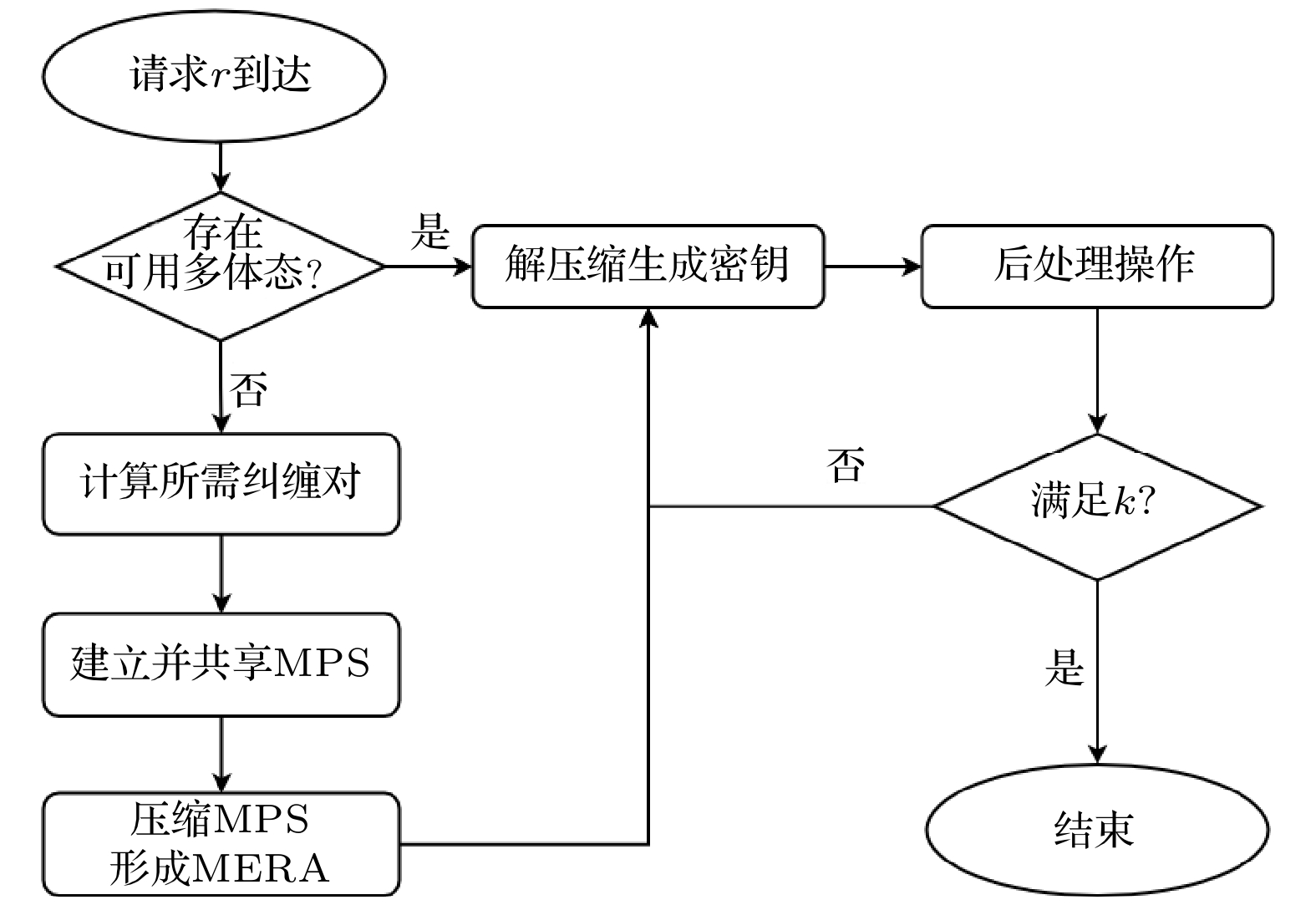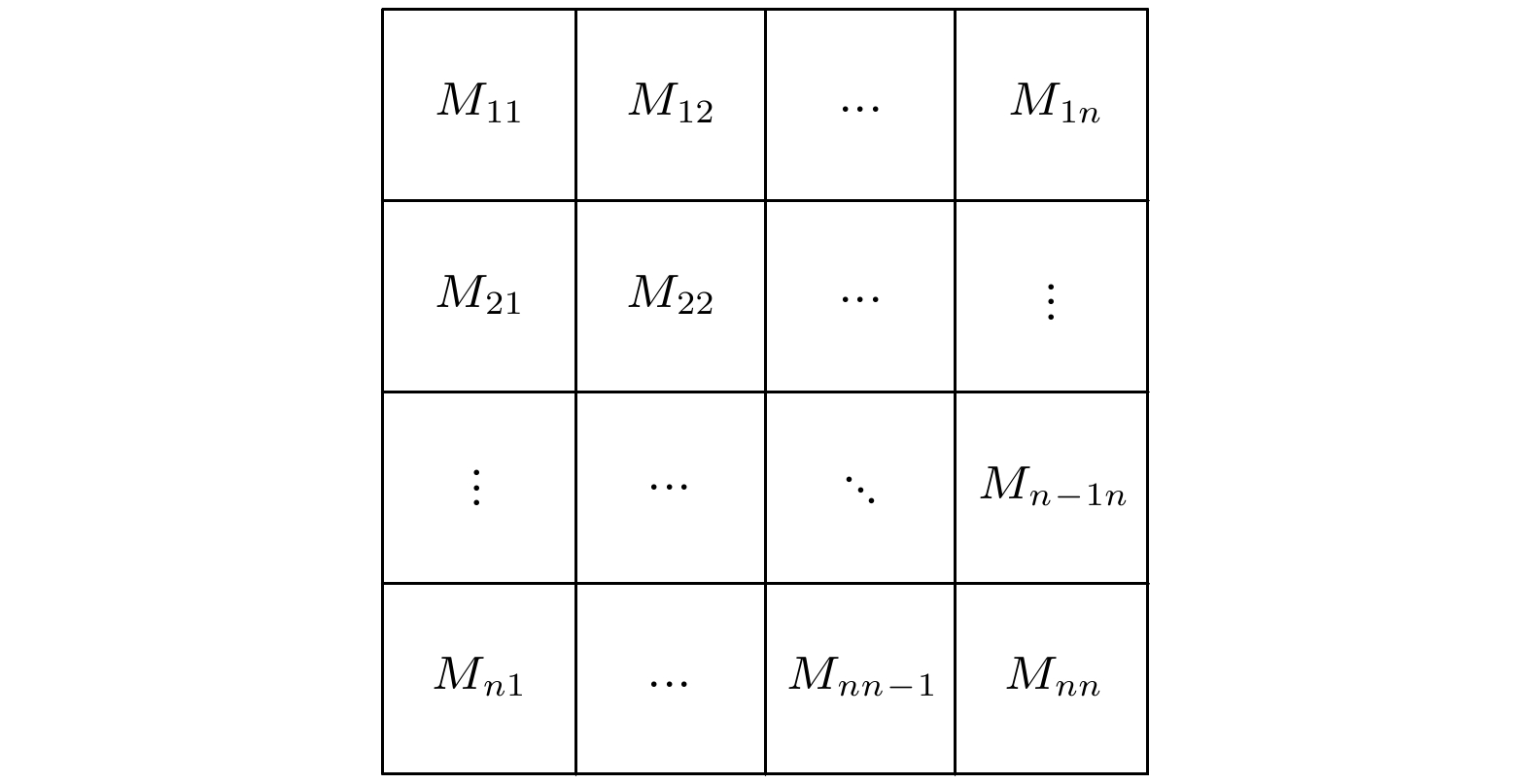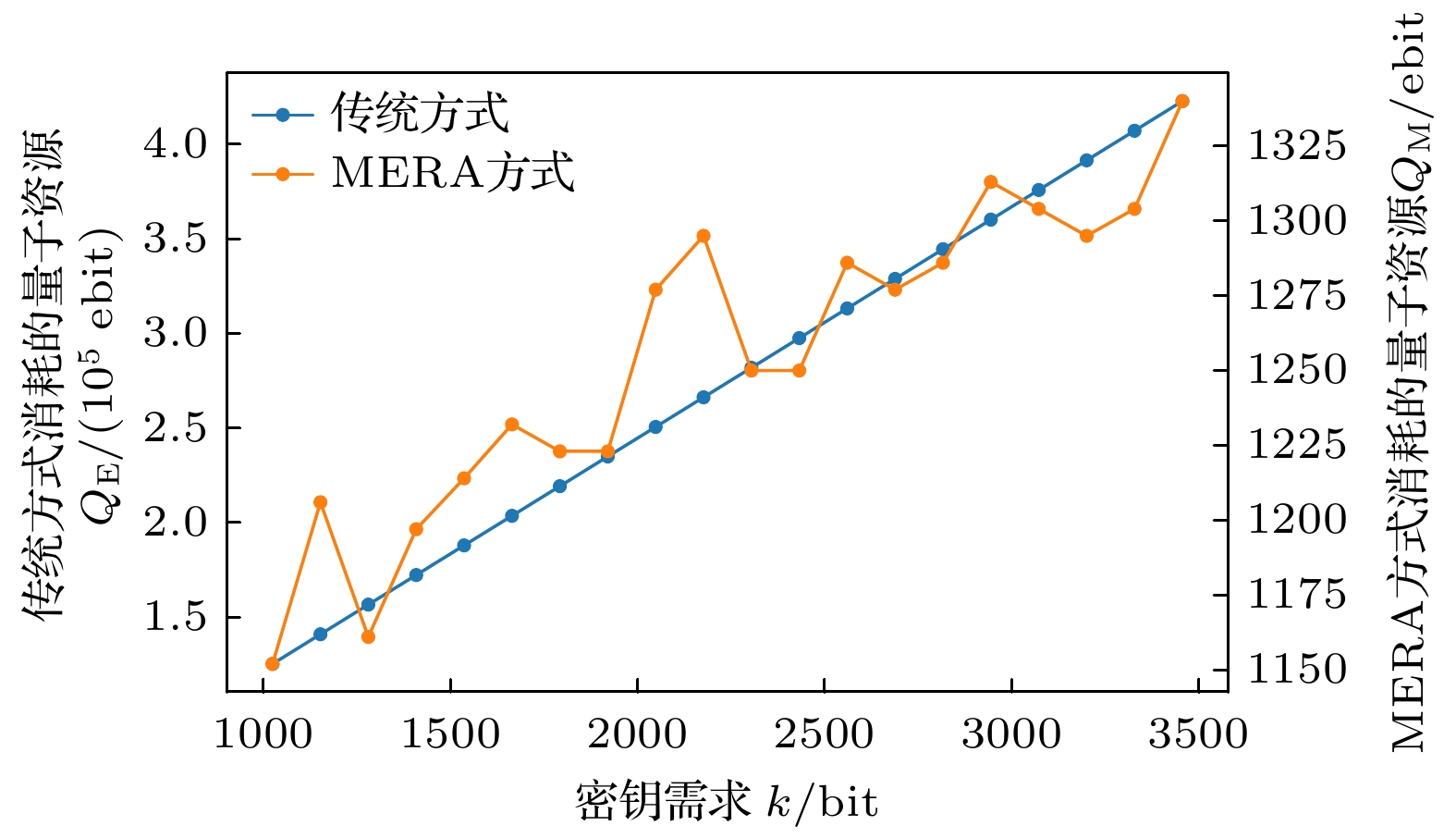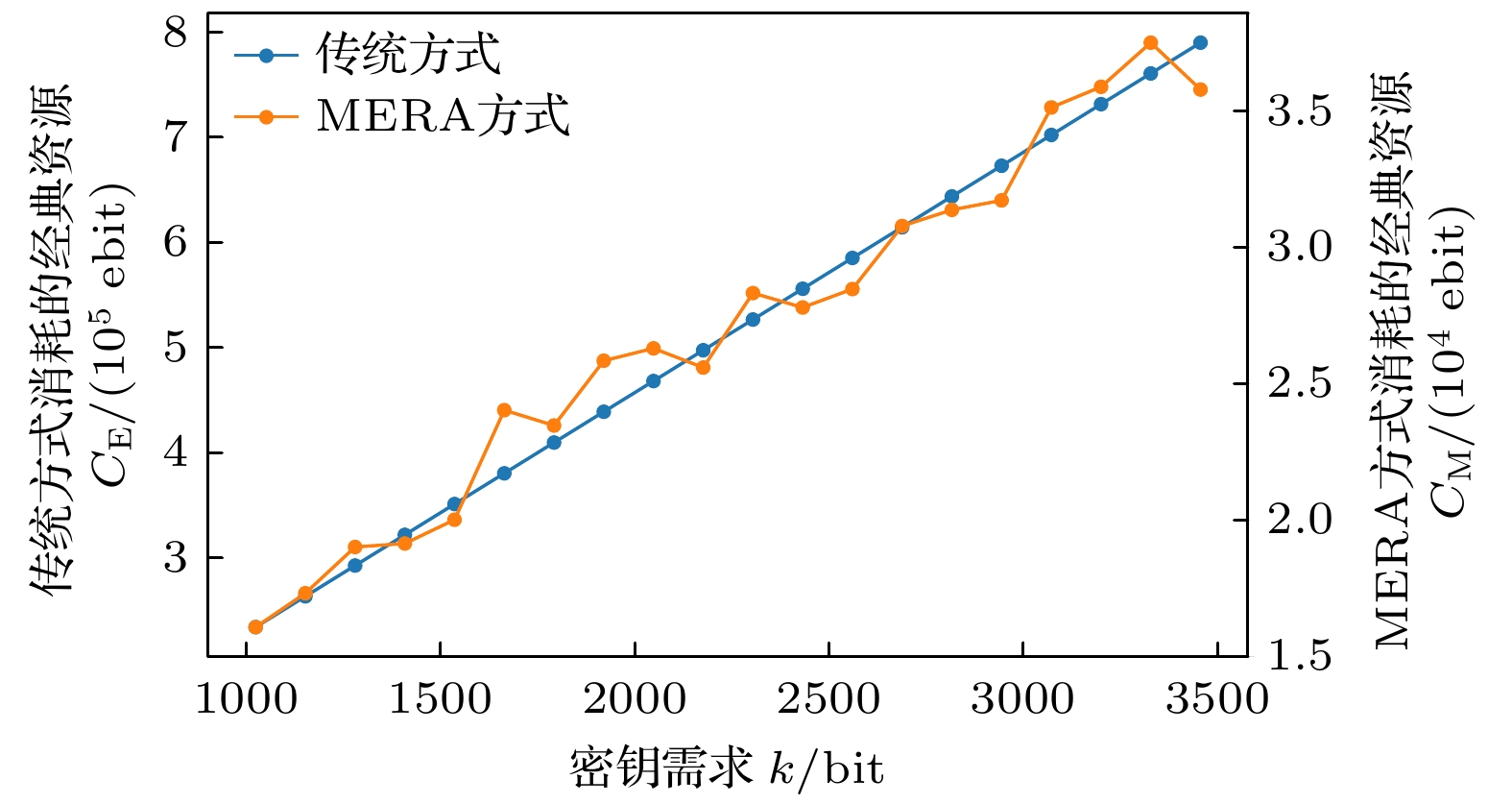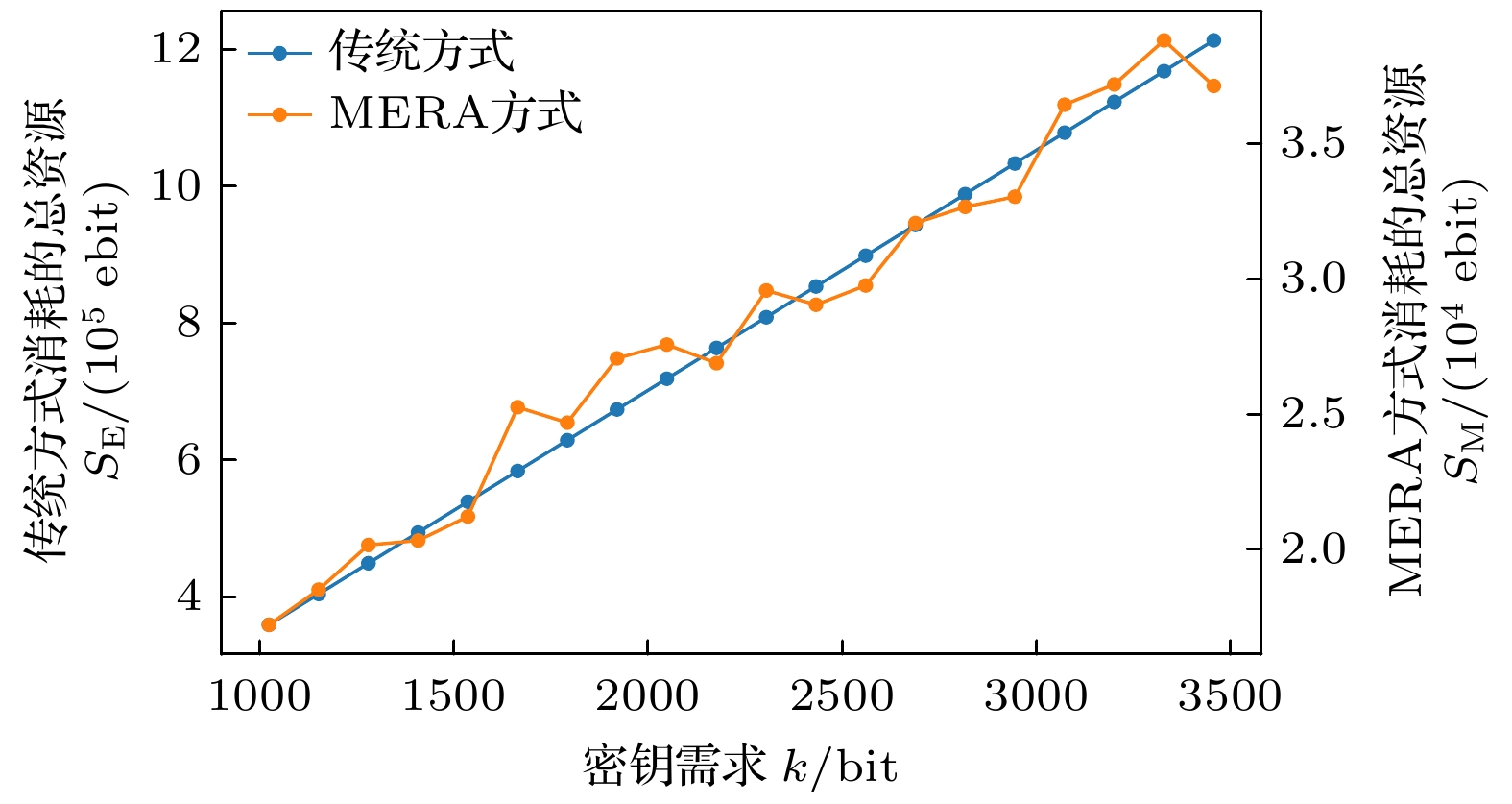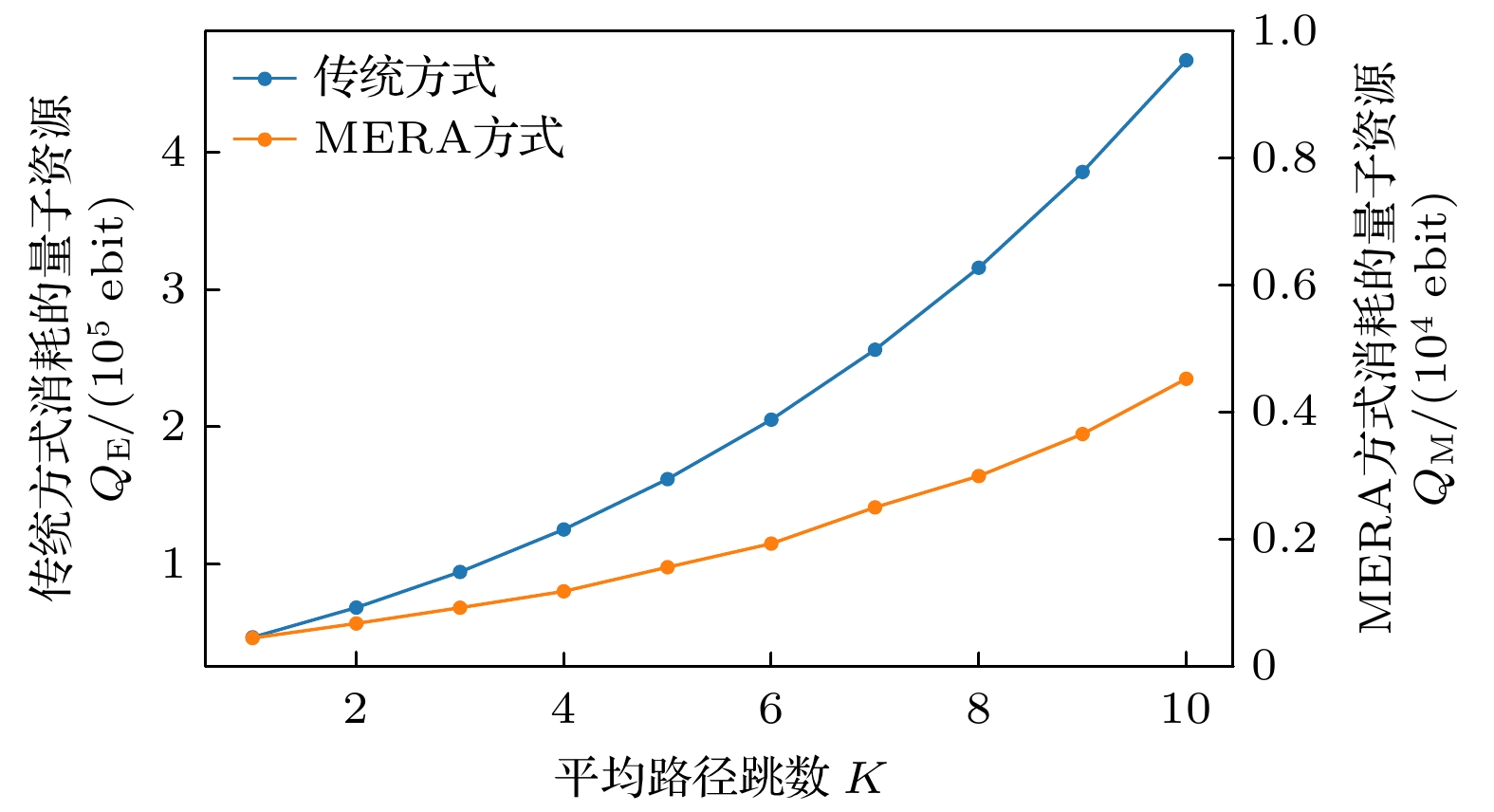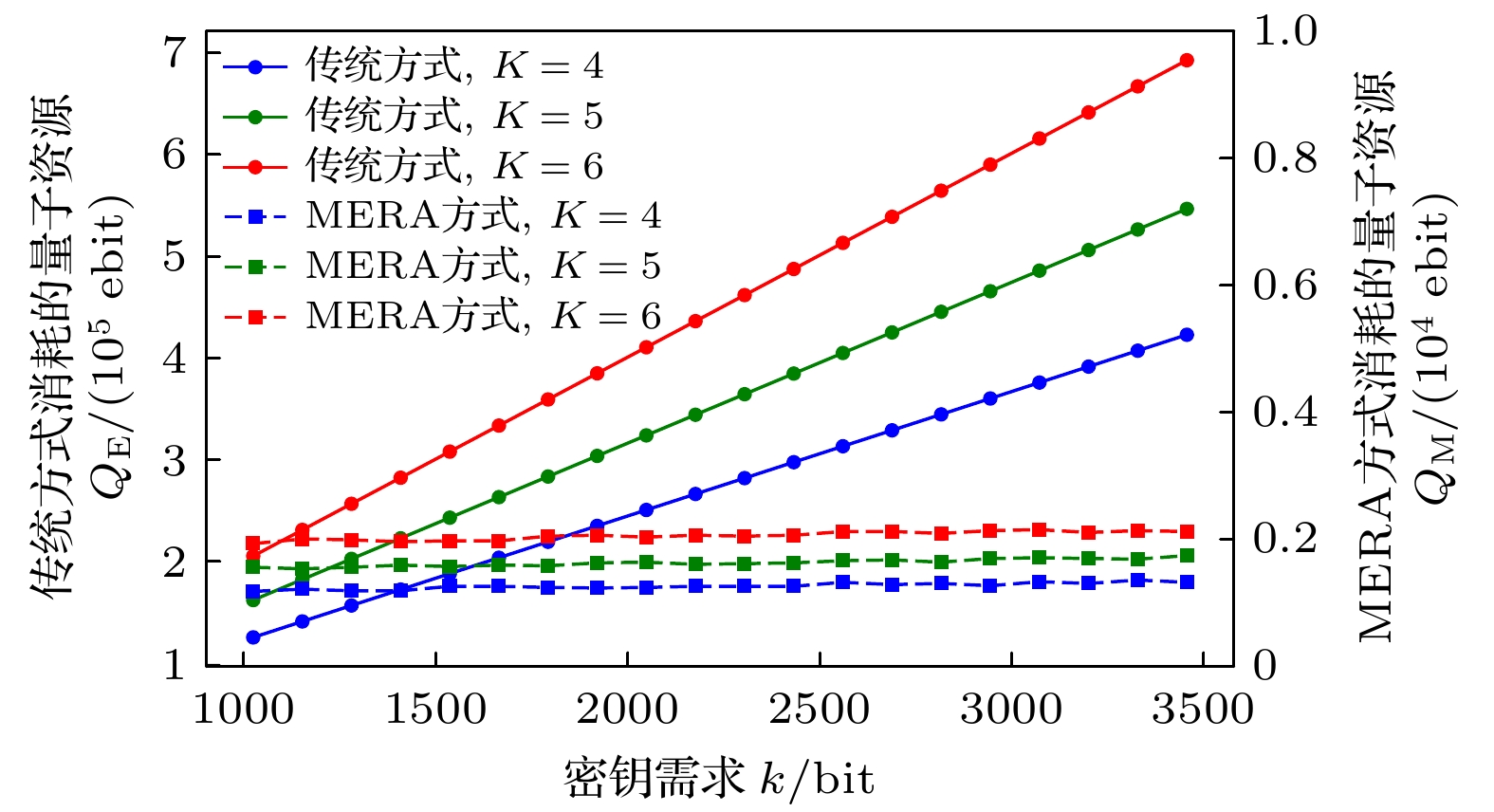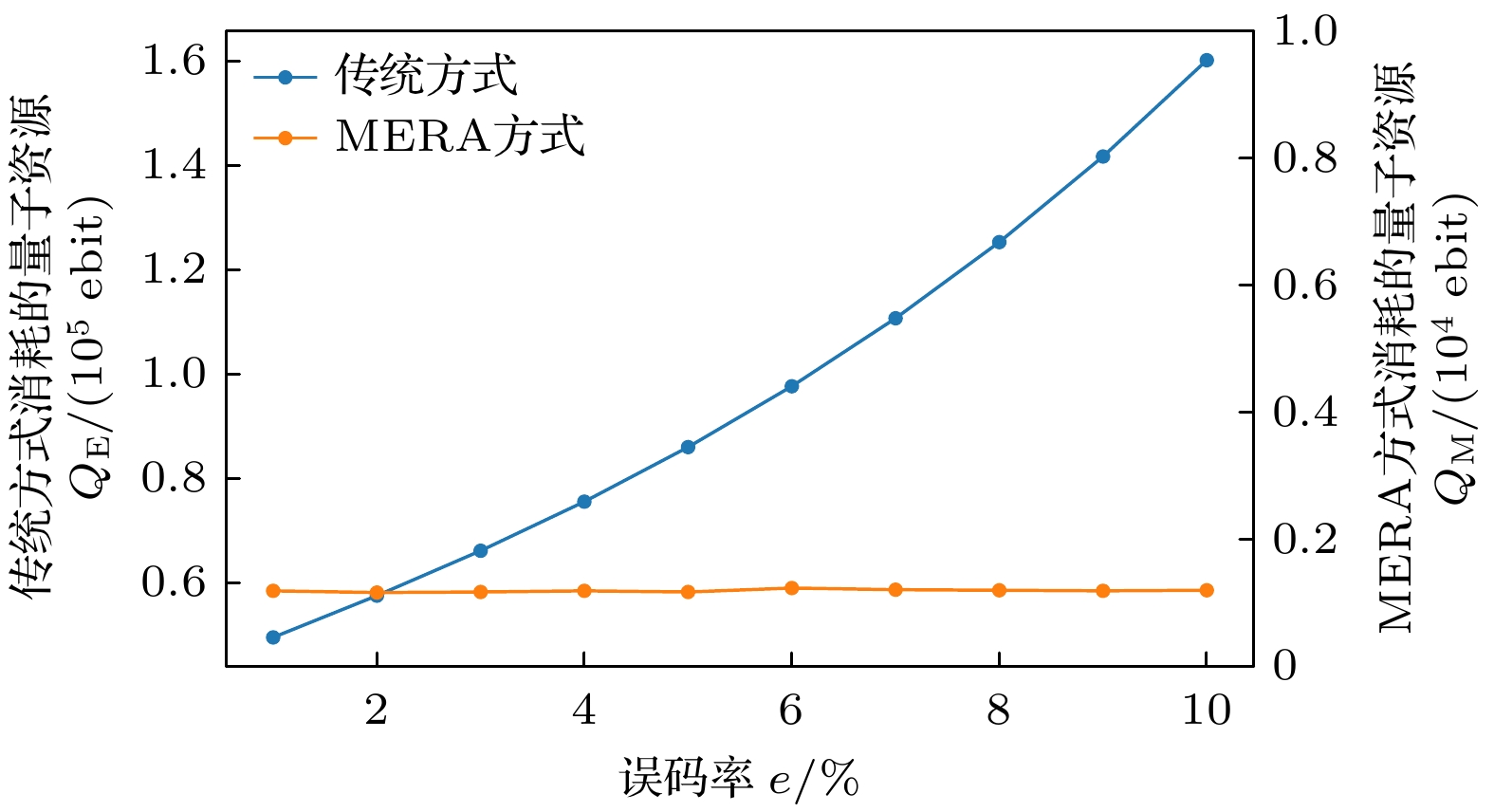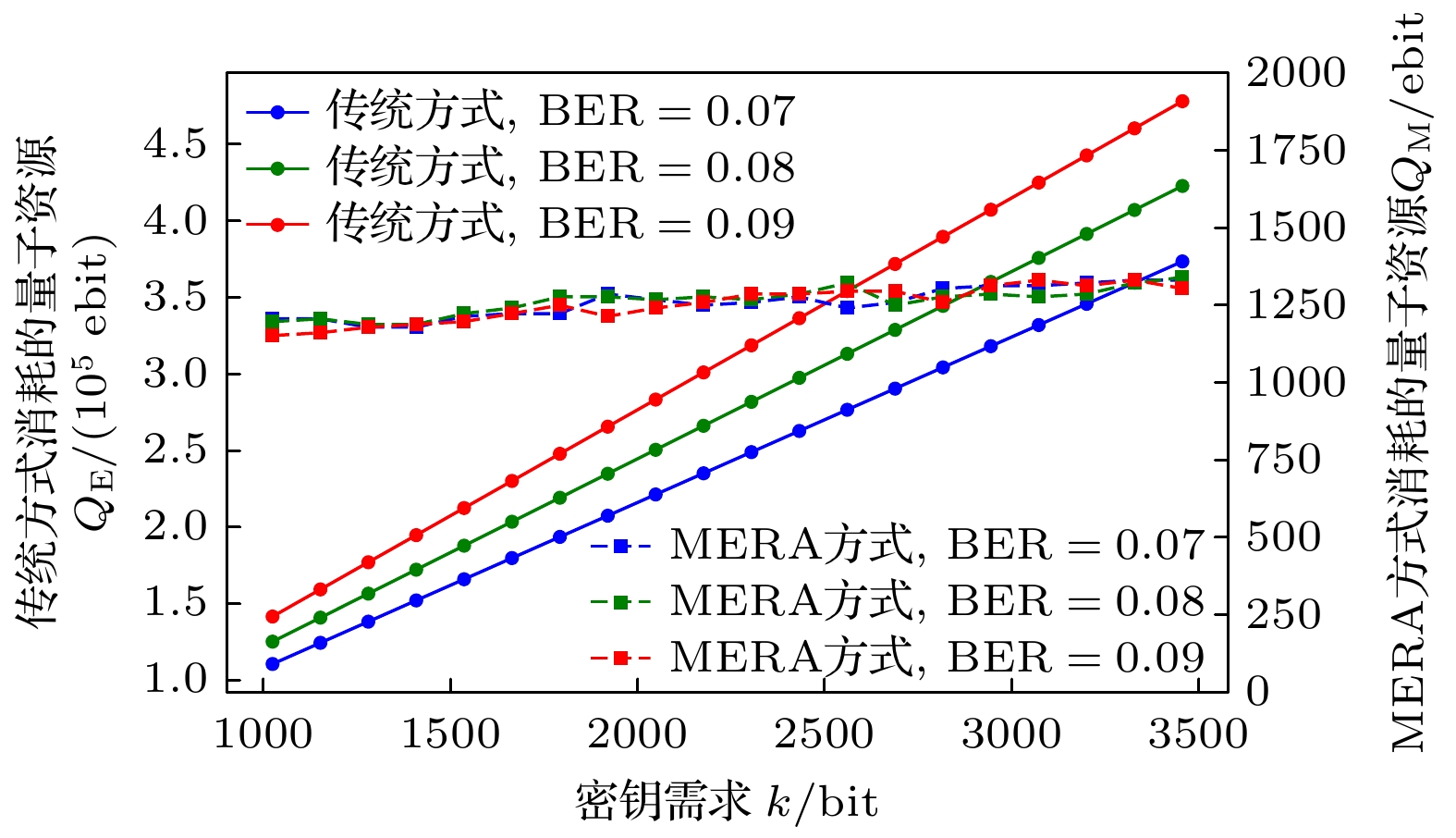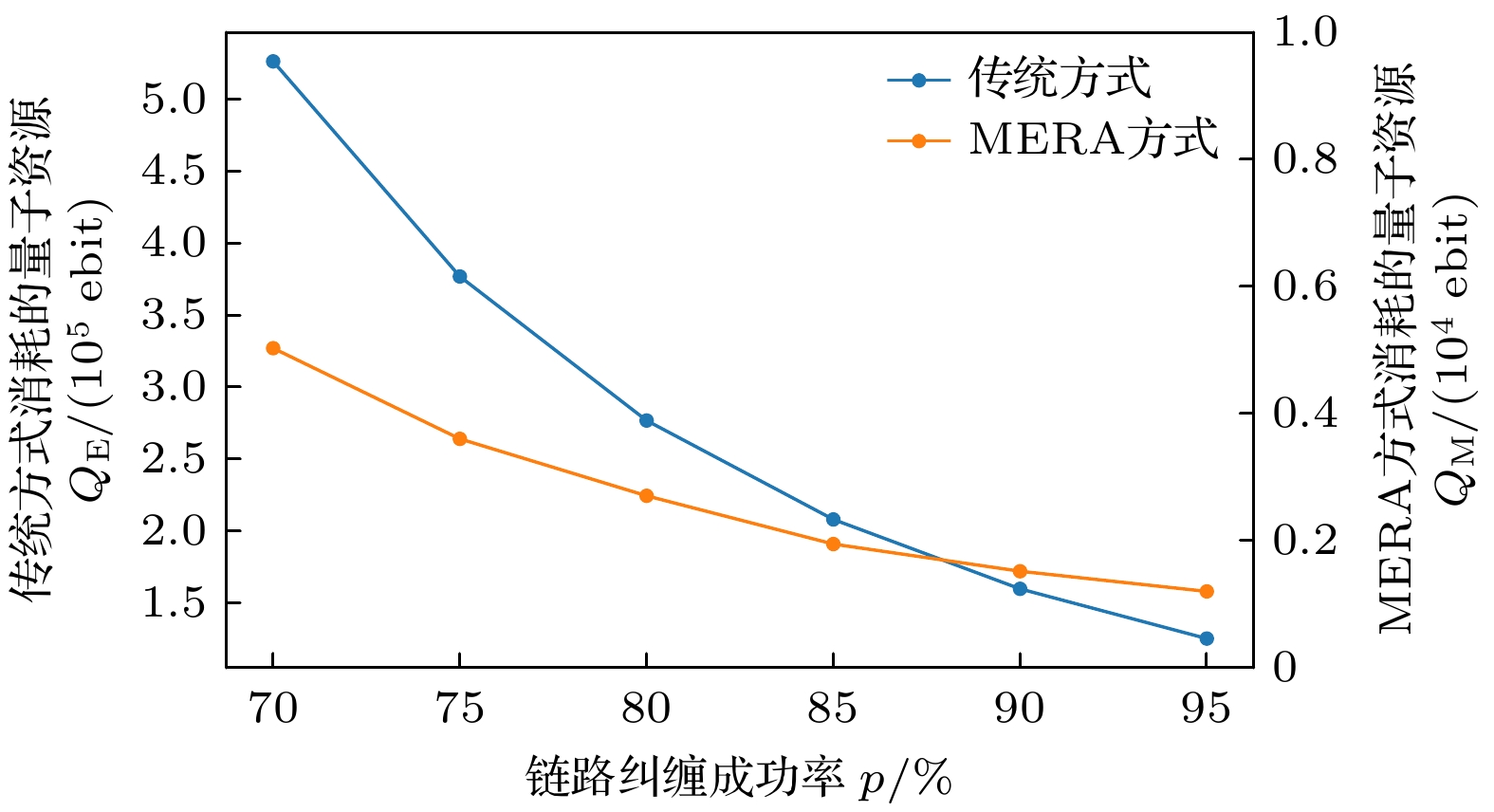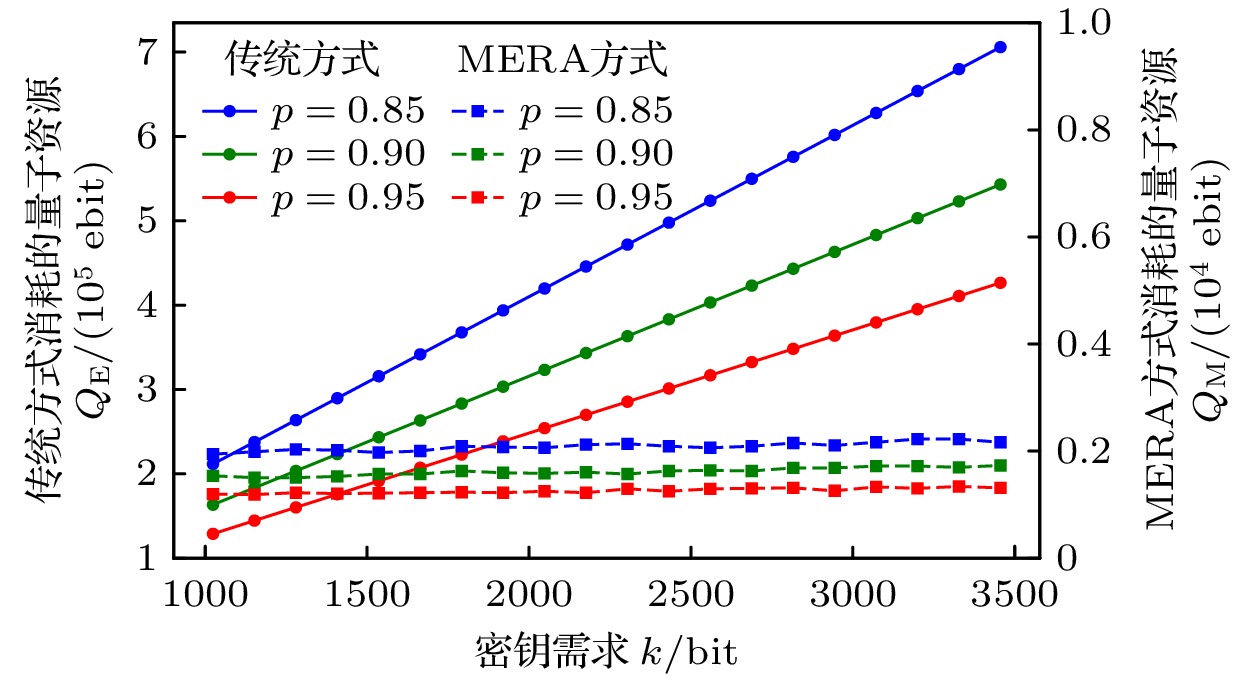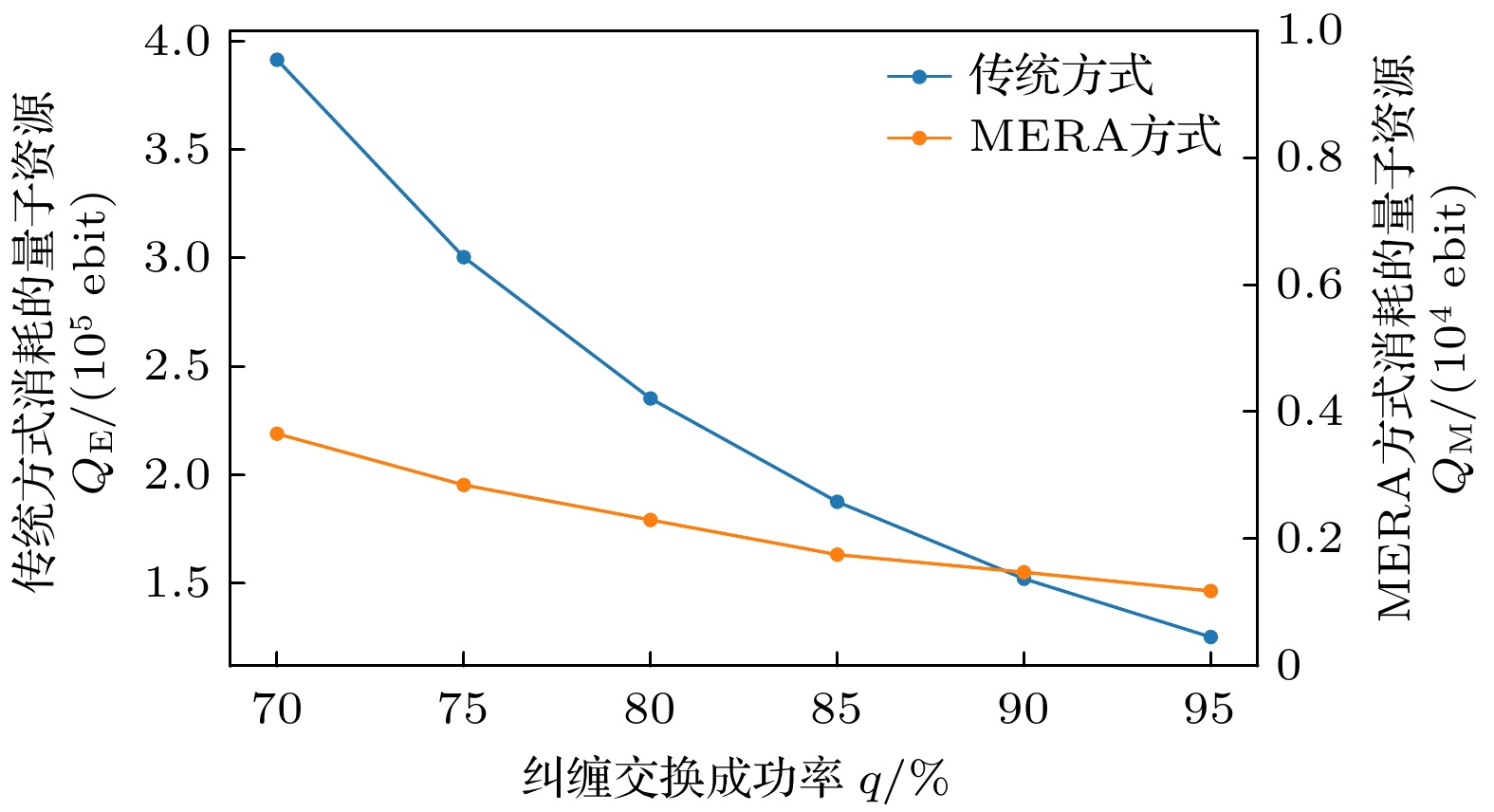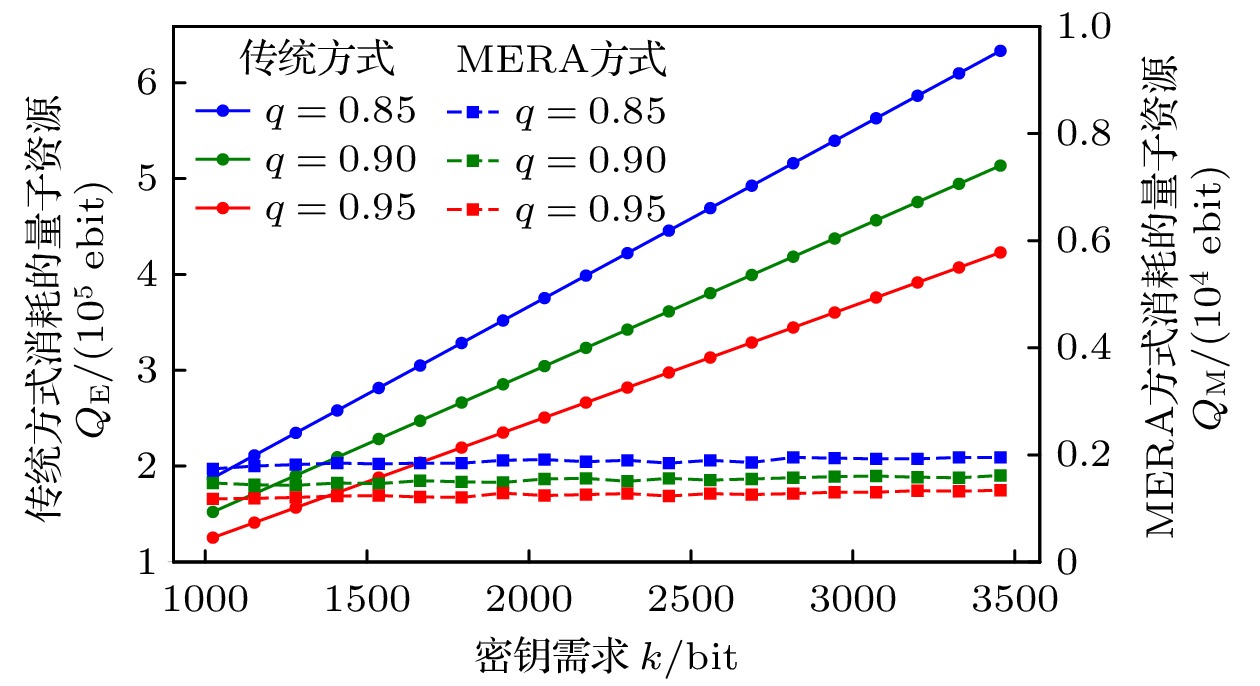-
量子密钥分发(quantum key distribution, QKD)技术因在确保通信安全方面的潜力而备受关注, 但其在大规模网络中的应用受限于量子资源的稀缺性和低效的利用率. 尤其在Ekert91协议中, 尽管利用了纠缠对进行密钥生成, 实际参与密钥生成的纠缠对数量有限, 导致资源利用率不高. 为了克服这一挑战, 本文提出一种基于多尺度纠缠重整化假设(multiscale entanglement renormalization ansatz, MERA)的QKD优化方案, 以提高纠缠资源的利用效率. 该方案利用MERA的分层结构和多体态压缩特性, 有效减少量子存储需求, 并显著提升纠缠对的利用率. 实验模拟显示, 在相同的加密请求(1024比特)和物理条件下, 与传统方法相比, 本文的方案节省了124151对纠缠资源, 既显著提高了资源的利用效率, 又未降低密钥生成过程的安全性, 有助于推动QKD技术在资源受限的环境中进一步发展和应用.
-
关键词:
- 量子密钥分发 /
- 多尺度纠缠重整化假设 /
- 资源利用率 /
- 安全性
Quantum key distribution (QKD) is a pivotal technology in the field of secure communication by using the principles of quantum mechanics to implement theoretically unbreakable encryption. However, QKD faces significant challenges in achieving large-scale deployment. The primary hurdle lies in the scarcity of quantum resources, especially entangled photon pairs, which are fundamental to protocols such as Ekert91. In traditional QKD implementations, only a small potion of the generated entanglement pairs contribute to generating the original key, resulting in lower efficiency and resource waste. Resolving this limitation is crucial to the advancement and scalability of QKD networks. This paper introduces an innovative approach to QKD by integrating the multiscale entanglement renormalization ansatz (MERA), a technique which is originally developed for many-body quantum systems. By utilizing MERA’s hierarchical structure, the proposed method not only improves the efficiency of entanglement distribution but also reduces the consumption of quantum resources. Specifically, MERA compresses many-body quantum states into lower-dimensional representations, allowing for the transmission and storage of entanglement in a more efficient manner. This compression significantly reduces the number of qubits required, optimizing both entanglement utilization and storage capacity in quantum networks. To evaluate the performance of this method, we conduct simulations under standardized conditions. In the simulation, a 1024-bit encryption request, an 8% error rate, an average path length of 4 hops in the quantum network, and a 95% success rate for link entanglement generation and entanglement swapping operations are assumed. These parameters reflect the real physical conditions in contemporary QKD networks. The results demonstrate that compared with traditional QKD protocols, the MERA-based approach saves 124151 entangled pairs, which is impressive. This significant reduction in resource consumption indicates the potential application of MERA in improving the efficiency of QKD systems without sacrificing security. Importantly, the security of the key exchange process remains intact, for the method inherently adheres to the principles of quantum mechanics, particularly the no-cloning theorem and the use of randomness in the decompression layer. Some conclusions can be drawn below. The MERA not only enhances the scalability of QKD by optimizing quantum resource allocation, but also maintains the necessary security guarantees for practical cryptographic applications. By integrating MERA into existing QKD frameworks, we can significantly reduce the resource overhead and make large-scale, secure quantum communication more feasible. These findings contribute a new dimension to the field of quantum cryptography, indicating that advanced quantum many-body techniques like MERA have the potential to unlock the full potential of quantum networks in real world. -
Keywords:
- quantum key distribution /
- multi-scale entanglement renormalization ansatz /
- resource utilization /
- security
[1] Wootters W K, Zurek W H 1982 Nature 299 802
 Google Scholar
Google Scholar
[2] Peev M, Pacher C, Alléaume R 2009 New J. Phys. 11 075001
 Google Scholar
Google Scholar
[3] Dianati M, Alléaume R, Gagnaire M 2008 Security Commun. Networks 1 57
 Google Scholar
Google Scholar
[4] Aguado A, Lopez V, Lopez D 2019 IEEE Commun. Mag. 57 20
[5] Donetti L, Hurtado P I, Munoz M A 2005 Phys. Rev. Lett. 95 188701
 Google Scholar
Google Scholar
[6] Li Z, Xue K P, Li J 2023 IEEE Commun. Surv. Tutor. 25 2133
 Google Scholar
Google Scholar
[7] Pant M, Krovi H, Towsley D 2019 npj Quantum Inf. 5 25
 Google Scholar
Google Scholar
[8] Shi S, Zhang X, Qian C 2024 IEEE/ACM Trans. Netw. 32 2205
 Google Scholar
Google Scholar
[9] Li J, Wang M, Xue K P 2022 IEEE Trans. Commun. 70 6748
 Google Scholar
Google Scholar
[10] Gu H Y, Li Z Y 2024 IEEE/ACM Trans. Netw. 1 125
[11] Ekert A 1991 Phys. Rev. Lett. 67 661
 Google Scholar
Google Scholar
[12] Bennett C H, Brassard G, Mermin N D 1992 Phys. Rev. Lett. 68 557
 Google Scholar
Google Scholar
[13] Li C, Li T, Liu Y X 2021 npj Quantum Inf. 7 10
 Google Scholar
Google Scholar
[14] 赖红 2023 物理学报 72 170301
 Google Scholar
Google Scholar
Lai H 2023 Acta Phys. Sin. 72 170301
 Google Scholar
Google Scholar
[15] Kim Y H, Kulik S P, Shih Y 2001 Phys. Rev. Lett. 86 1370
 Google Scholar
Google Scholar
[16] Cincio L, Dziarmaga J, Rams M M 2008 Phys. Rev. Lett. 100 240603
 Google Scholar
Google Scholar
[17] Lai H, Pieprzyk J, Pan L 2022 Phys. Rev. A 106 052403
 Google Scholar
Google Scholar
[18] Pirandola S, García-Patrón R, Braunstein S L 2009 Phys. Rev. Lett. 102 050503
 Google Scholar
Google Scholar
[19] Pirandola S, Laurenza R, Ottaviani C 2017 Nat. Commun. 8 1500
 Google Scholar
Google Scholar
[20] Wehner S, Elkouss D, Hanson R 2018 Science 362 9288
 Google Scholar
Google Scholar
[21] Bernien H, Hensen B, Pfaff W 2013 Nature 497 86
 Google Scholar
Google Scholar
[22] Olmschenk S, Matsukevich D N, Maunz P 2009 Science 323 486
 Google Scholar
Google Scholar
[23] Pan J W, Bouwmeester D, Weinfurter H 1998 Phys. Rev. Lett. 80 3891
 Google Scholar
Google Scholar
[24] Bravyi S, Cross A W, Gambetta J M 2024 Nature 627 778
 Google Scholar
Google Scholar
[25] Bersin E, Sutula M, Huan Y Q 2024 PRX Quantum 5 010303
 Google Scholar
Google Scholar
[26] Fan R, Bao Y, Altman E 2024 PRX Quantum 5 020343
 Google Scholar
Google Scholar
[27] Zhang Q, Lai H, Pieprzyk J 2022 Phys. Rev. A 105 032439
 Google Scholar
Google Scholar
[28] Lai H, Pieprzyk J, Pan L 2023 Sci. China Inf. Sci. 66 180510
 Google Scholar
Google Scholar
[29] Shannon C E 1949 Bell Syst. Tech. J. 28 656
 Google Scholar
Google Scholar
[30] Orús R 2014 Ann. Phys. 349 117
 Google Scholar
Google Scholar
[31] Chen L Q, Zhao M N, Yu K L 2021 Quantum Inf. Process. 20 1
 Google Scholar
Google Scholar
[32] Elkouss D, Martinez J, Lancho D 2010 IEEE Information Theory Workshop on Information Theory Cairo, Egypt, October 10–13, 2010 p1
[33] Gisin N, Ribordy G, Tittel W 2002 Rev. Mod. Phys. 74 145
 Google Scholar
Google Scholar
[34] Wu X, Zhu W P, Yan J 2017 IEEE Trans. Veh. Technol. 66 8223
 Google Scholar
Google Scholar
[35] Bennett C H, Brassard G, Robert J M 1988 SIAM J. Comput. 17 210
 Google Scholar
Google Scholar
[36] Eibl M, Kiesel N, Bourennane M, et al. 2004 Phys. Rev. Lett. 92 077901
 Google Scholar
Google Scholar
[37] Briegel H J, Raussendorf R 2001 Phys. Rev. Lett. 86 910
 Google Scholar
Google Scholar
[38] Affleck I, Kennedy T, Lieb E H 2004 Condensed Matter Phys. Exactly Soluble Models: Selecta Elliott (Berlin: Springer-Verlag) pp249–252
[39] Affleck I 1989 J. Phys. Condens. Matter 1 3047
 Google Scholar
Google Scholar
-
表 1 网络请求属性及其取值范围
Table 1. Network request attributes and their value ranges.
属性 描述 取值范围 S 发送方 N/A D 接收方 N/A k 需求量 [1024, 4096] P 优先级 [1, 5] $ \Delta t $ 可接受时延 [1, 60] -
[1] Wootters W K, Zurek W H 1982 Nature 299 802
 Google Scholar
Google Scholar
[2] Peev M, Pacher C, Alléaume R 2009 New J. Phys. 11 075001
 Google Scholar
Google Scholar
[3] Dianati M, Alléaume R, Gagnaire M 2008 Security Commun. Networks 1 57
 Google Scholar
Google Scholar
[4] Aguado A, Lopez V, Lopez D 2019 IEEE Commun. Mag. 57 20
[5] Donetti L, Hurtado P I, Munoz M A 2005 Phys. Rev. Lett. 95 188701
 Google Scholar
Google Scholar
[6] Li Z, Xue K P, Li J 2023 IEEE Commun. Surv. Tutor. 25 2133
 Google Scholar
Google Scholar
[7] Pant M, Krovi H, Towsley D 2019 npj Quantum Inf. 5 25
 Google Scholar
Google Scholar
[8] Shi S, Zhang X, Qian C 2024 IEEE/ACM Trans. Netw. 32 2205
 Google Scholar
Google Scholar
[9] Li J, Wang M, Xue K P 2022 IEEE Trans. Commun. 70 6748
 Google Scholar
Google Scholar
[10] Gu H Y, Li Z Y 2024 IEEE/ACM Trans. Netw. 1 125
[11] Ekert A 1991 Phys. Rev. Lett. 67 661
 Google Scholar
Google Scholar
[12] Bennett C H, Brassard G, Mermin N D 1992 Phys. Rev. Lett. 68 557
 Google Scholar
Google Scholar
[13] Li C, Li T, Liu Y X 2021 npj Quantum Inf. 7 10
 Google Scholar
Google Scholar
[14] 赖红 2023 物理学报 72 170301
 Google Scholar
Google Scholar
Lai H 2023 Acta Phys. Sin. 72 170301
 Google Scholar
Google Scholar
[15] Kim Y H, Kulik S P, Shih Y 2001 Phys. Rev. Lett. 86 1370
 Google Scholar
Google Scholar
[16] Cincio L, Dziarmaga J, Rams M M 2008 Phys. Rev. Lett. 100 240603
 Google Scholar
Google Scholar
[17] Lai H, Pieprzyk J, Pan L 2022 Phys. Rev. A 106 052403
 Google Scholar
Google Scholar
[18] Pirandola S, García-Patrón R, Braunstein S L 2009 Phys. Rev. Lett. 102 050503
 Google Scholar
Google Scholar
[19] Pirandola S, Laurenza R, Ottaviani C 2017 Nat. Commun. 8 1500
 Google Scholar
Google Scholar
[20] Wehner S, Elkouss D, Hanson R 2018 Science 362 9288
 Google Scholar
Google Scholar
[21] Bernien H, Hensen B, Pfaff W 2013 Nature 497 86
 Google Scholar
Google Scholar
[22] Olmschenk S, Matsukevich D N, Maunz P 2009 Science 323 486
 Google Scholar
Google Scholar
[23] Pan J W, Bouwmeester D, Weinfurter H 1998 Phys. Rev. Lett. 80 3891
 Google Scholar
Google Scholar
[24] Bravyi S, Cross A W, Gambetta J M 2024 Nature 627 778
 Google Scholar
Google Scholar
[25] Bersin E, Sutula M, Huan Y Q 2024 PRX Quantum 5 010303
 Google Scholar
Google Scholar
[26] Fan R, Bao Y, Altman E 2024 PRX Quantum 5 020343
 Google Scholar
Google Scholar
[27] Zhang Q, Lai H, Pieprzyk J 2022 Phys. Rev. A 105 032439
 Google Scholar
Google Scholar
[28] Lai H, Pieprzyk J, Pan L 2023 Sci. China Inf. Sci. 66 180510
 Google Scholar
Google Scholar
[29] Shannon C E 1949 Bell Syst. Tech. J. 28 656
 Google Scholar
Google Scholar
[30] Orús R 2014 Ann. Phys. 349 117
 Google Scholar
Google Scholar
[31] Chen L Q, Zhao M N, Yu K L 2021 Quantum Inf. Process. 20 1
 Google Scholar
Google Scholar
[32] Elkouss D, Martinez J, Lancho D 2010 IEEE Information Theory Workshop on Information Theory Cairo, Egypt, October 10–13, 2010 p1
[33] Gisin N, Ribordy G, Tittel W 2002 Rev. Mod. Phys. 74 145
 Google Scholar
Google Scholar
[34] Wu X, Zhu W P, Yan J 2017 IEEE Trans. Veh. Technol. 66 8223
 Google Scholar
Google Scholar
[35] Bennett C H, Brassard G, Robert J M 1988 SIAM J. Comput. 17 210
 Google Scholar
Google Scholar
[36] Eibl M, Kiesel N, Bourennane M, et al. 2004 Phys. Rev. Lett. 92 077901
 Google Scholar
Google Scholar
[37] Briegel H J, Raussendorf R 2001 Phys. Rev. Lett. 86 910
 Google Scholar
Google Scholar
[38] Affleck I, Kennedy T, Lieb E H 2004 Condensed Matter Phys. Exactly Soluble Models: Selecta Elliott (Berlin: Springer-Verlag) pp249–252
[39] Affleck I 1989 J. Phys. Condens. Matter 1 3047
 Google Scholar
Google Scholar
计量
- 文章访问数: 4129
- PDF下载量: 95
- 被引次数: 0













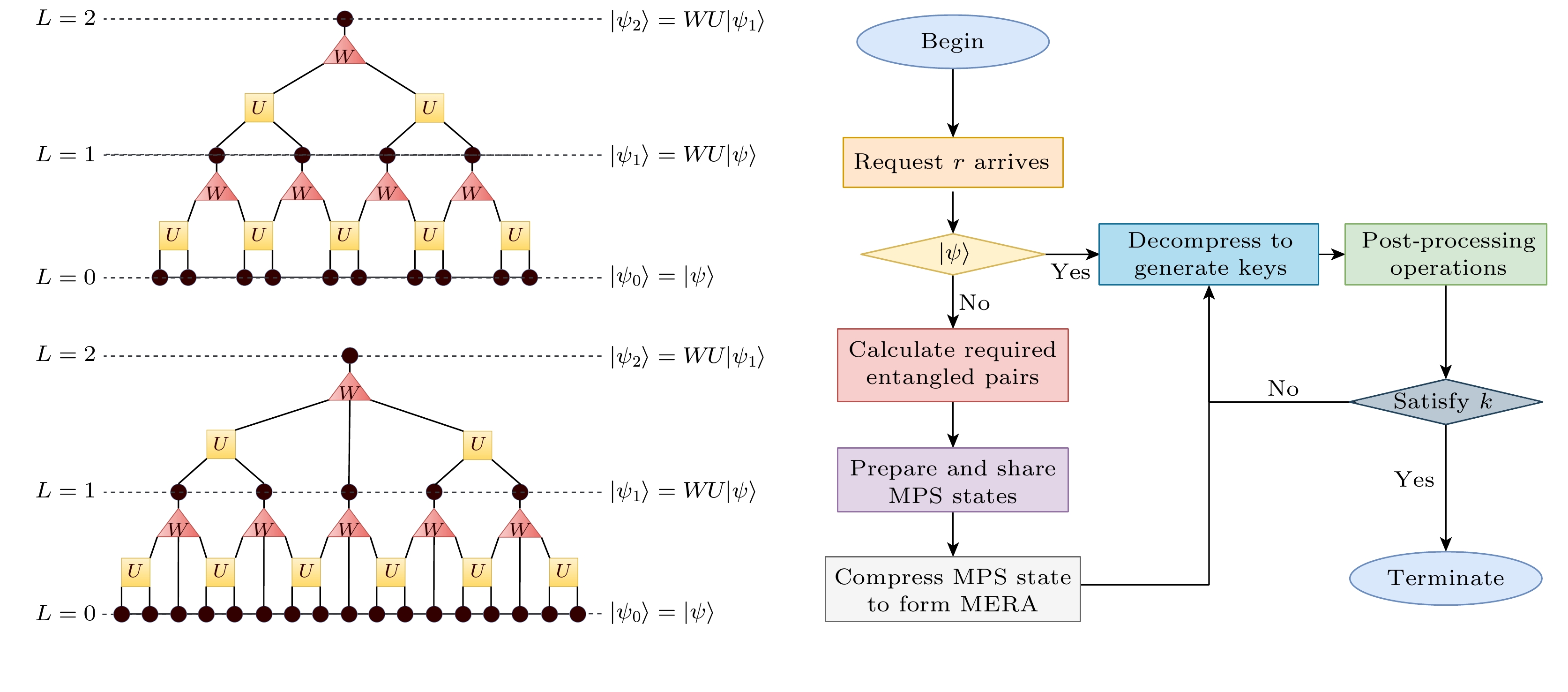
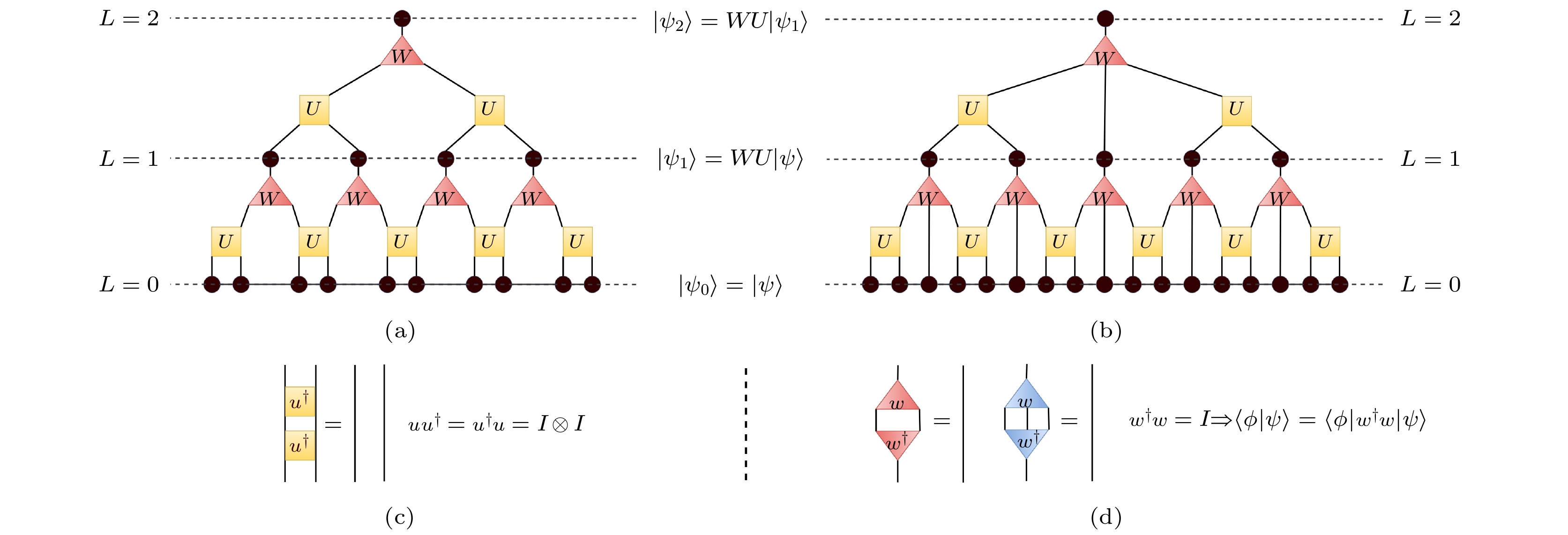
 下载:
下载:



